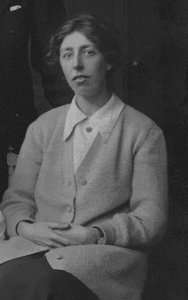Muriel Wheldale Onslow
| Muriel Wheldale Onslow | |
|---|---|
 | |
| Born |
31 March 1880 Birmingham, England |
| Died | 19 May 1932 (aged 52) |
| Fields | Biochemical genetics |
| Alma mater | University of Cambridge |
Muriel Wheldale Onslow (31 March 1880 – 19 May 1932) was a British biochemist. She studied the chemistry pf the pigments of flowers and she was involved with the early development of biochemical genetics.
Life
Onslow was born on 31 March 1880 in Birmingham, England. She attended the King Edward VI High School in Birmingham and then matriculated at Newnham College, Cambridge in 1900.
At Cambridge she majored in botany. She received no degree from Cambridge, despite taking First Class Honours in both parts of the Natural Sciences Tripos, because Cambridge did not award degrees to women until 1948.[1]
In 1903 she joined William Bateson's genetics lab at Cambridge where she began her study focusing on the interaction of factors and of the inheritance of petal color in Antirrhinum (snapdragons). By 1906 Wheldale had enough data to formulate a rudimentary factorial analysis on snapdragon inheritance. In 1907, Wheldale identified and, with the help of Bateson, termed the phenomenon of dominant-like relationship between different pairs of nonallelomorphic factors as epistasis. Wheldale's study of genetics on flower coloration ultimately gained her the most recognition, with the 1907 publication of a full factorial analysis of flower color inheritance in snapdragons and the four subsequent papers she published from 1909 to 1910. This work culminated in the 1916 publication of her first book, The Anthocyanin Pigments of Plants.[2]
In 1914 Onslow joined the biochemistry lab of Frederick Gowland Hopkins, where she pursued the biochemical aspects of petal color, whose genetics she had elucidated at Bateson's lab. In combining genetics and biochemistry she became one of the first biochemical geneticists and paved the way for the later successes of such seminal investigators as Edward Tatum and George Beadle.
In 1919 Onslow married biochemist Victor Alexander Herbert Huia Onslow, second son of the 4th Earl of Onslow. Victor Onslow was paraplegic and died in 1922.
In 1926 she was one of the first women appointed as a lecturer at Cambridge. Amongst her followers was Rose Scott-Moncrieff who went on to identify the first crystalline form of Primulin in about 1930. This was the first crystalline anthocyanin pigment ever identified. Onslow and Scott-Moncrieff have been credited with founding biochemical genetics, although Scott-Moncrieff is thought to have the stronger claim.[3]
Muriel Onslow died on 19 May 1932.
In 2010 the Royal Institution of Great Britain staged a play, entitled "Blooming Snapdragons," about four early-20th-century women biochemists, one of whom was Muriel Onslow.
Books by Muriel Onslow
- The Anthocyanin Pigments of Plants, 1916, revised in 1925
- Practical Plant Biochemistry, 1920
- Principles of Plant Biochemistry, Volume 1, 1931
References
- ↑ At Last a Degree of Honour for 900 Cambridge Women, Suzanna Chambers, 30 May 1998, The Independent, Retrieved July 2016
- ↑ Wheldale, Muriel (1916). The Anthocyanin Pigments of Plants. University Press, Cambridge.
- ↑ Rose Scott-Moncrieff and the dawn of (Bio) Chemical Genetics, Cathie Martin, April 2016, Biochemical classics, Biochemist.org, Retrieved 5 July 2016
External links
- Works by or about Muriel Wheldale Onslow at Internet Archive
- "Blooming Snapdragons". The Royal Institution of Great Britain. 14 July 2010.
- Creese, Mary R. S. (2004). "Onslow, Muriel Wheldale (1880–1932)". Oxford Dictionary of National Biography. doi:10.1093/ref:odnb/46433.
- Gould, Kevin S. (2010-07-26). "Chapter 7 Muriel Wheldale Onslow and the Rediscovery of Anthocyanin Function in Plants". Recent Advances in Polyphenol Research. p. 206. ISBN 978-1-4051-9399-3.
- McDonald, IG (1932). "Obituary Notice: Muriel Wheldale Onslow. 1880—1932". Biochemistry Journal. 26 (4): 915–916. PMC 1260991
 . PMID 16744946.
. PMID 16744946. - Rayner-Canham, Marelene; Rayner-Canham, Geoffrey (2002). "Muriel Wheldale Onslow (1880–1932): pioneer plant biochemist" (PDF). The Biochemist.
- Richmond, Marsha L. (2007). "Muriel Wheldale Onslow and Early Biochemical Genetics". Journal of the History of Biology. 40 (3): 389–426. doi:10.1007/s10739-007-9134-8. PMID 18380053.